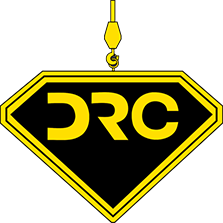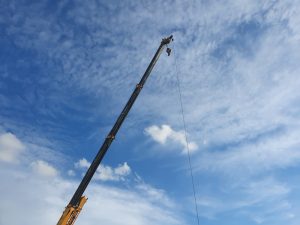There are so many types of cranes and many different needs for them. Each type of crane is specialized for its kind of job site. Because of this, it can be overwhelming to learn the many different types. To make it easy, we have highlighted 10 of the most common kinds of cranes used in construction projects today!
What are Common Cranes Used for in Construction Today?
Not all cranes are created equal. We will discuss the top 10 common types of cranes used for construction sites in today’s society. To do so, we are discussing two primary groups of cranes: mobile and fixed cranes. In this blog, we have outlined some of the specialized uses for these 10 types of cranes in both the mobile and the fixed crane categories.
Mobile cranes
Mobile are popular for construction because they can include truck-mounted cranes or crawlers. This allows for easy maneuvering through job sites and rough terrain. Mobile cranes come in many shapes and sizes, allowing for versatility at many different kinds of sites.
Crawler crane
Constructed with steel tracks instead of wheels, a crawler crane offers stability on soft ground, preventing sinking. Many feature telescopic arms, providing versatility across different terrains. However, there are some limits to these cranes including their lack of turning capacity and a bulky design. This means that they require a specialized setup and transportation between sites.
Rough terrain crane
As the name implies, these cranes are ideal for off-road and rugged terrain. It excels in lifting and transporting tasks even over the most uneven surfaces. Similar to a crawler crane, it can accommodate telescopic booms.
However, unlike the crawler crane, it features four tires and four-wheel drive for enhanced mobility. Additionally, its four-wheel drive capability provides superior traction, ensuring stability on challenging surfaces. With its versatility and maneuverability, this crane is well-suited for various construction and industrial applications.
Floating crane.
You might have encountered one of these on an oil rig or at a port. Commonly used for marine projects, a floating crane, also known as a crane vessel or crane ship, has been utilized since the Middle Ages. What distinguishes a floating crane from other cranes is its operation on water. These vessels play a crucial role in maritime construction, salvage operations, and port infrastructure development.
Vehicle-mounted crane
Consisting of a carrier and a boom, this two-part crane is primarily utilized for equipment loading and transportation at construction sites. It’s capable of highway travel for efficient mobility. Counterweights and outriggers can be incorporated to improve vehicle stability, enabling smooth movement even when carrying substantial loads at slow speeds. These features help to ensure safety and efficiency during heavy-duty operations.
Railroad crane
Have you ever noticed a crane moving on railroad tracks? That would be a railroad crane, specifically designed for the construction, maintenance, and repair of railway lines. Equipped with flanged wheels, a railroad crane is exclusively able to travel on railway tracks.
These specialized cranes play a crucial role in ensuring the smooth operation and safety of railway infrastructure. With their robust capabilities, railroad cranes are essential assets in the maintenance and expansion of railway systems worldwide.
Aerial crane.
Also recognized as a “sky crane,” this type of crane is typically a helicopter designed to transport substantial loads, accessing and lifting materials in locations challenging for conventional cranes to reach. Its versatility and aerial capabilities make it essential for tasks such as construction in remote or inaccessible areas and aerial firefighting operations. With its ability to navigate rough terrain and reach isolated areas, the sky crane is a vital asset in rescue operations and remote construction projects.
Fixed cranes
Fixed cranes are a staple for project durations, typically being assembled on-site for construction tasks. While lacking mobility, they excel in managing heavier loads and achieving impressive heights, making them indispensable for large-scale projects requiring precision and strength. Additionally, their stability ensures reliable performance throughout the project’s duration.
Telescopic handler crane
The boom (or arm) of a telescopic crane features a hydraulic cylinder, similar to a telescope, allowing it to adjust its length as needed. While categorized as a fixed crane, a telescopic handler crane can be mounted on a truck for convenient transportation between job sites. Its key advantage lies in its adaptability; the boom can retract and compact itself, proving invaluable for short-term projects or rescue missions where maneuverability is crucial. This flexibility enhances efficiency and versatility in diverse work scenarios.
Tower crane
As anticipated, a tower crane is known for its remarkable height-reaching capabilities. Tower cranes are an example of overhead cranes. Controlled from its operating cab, the crane’s jib extends horizontally from the mast, situated atop a concrete base.
Specifically engineered to stand with tall buildings, tower cranes increase in height alongside the structure. With adaptability and a sky-scraper size, these construction cranes are indispensable assets when it comes to vertical development.
Hammerhead crane
The Hammerhead crane is a fixed-jib crane that comprises a horizontal double cantilever mounted on a steel-braced tower that rotates for versatility. With a lifting capacity of up to 350 tons, it excels in handling exceptionally heavy loads. One example of its common uses is for lifting components for battleships. This strong fixed crane is for sites that require exceptionally heavy lifting even in a smaller space.
Level-luffing crane
Primarily utilized for loading and unloading container ships, the level-luffing crane features a hinged jib that adjusts vertically while keeping the hook fixed. When operating at ground level, cautious movement of the jibs is essential to prevent any potential hazards or damage. These cranes ensure efficient cargo handling with their specialized design, contributing to smooth maritime logistics operations.
Having a crane on a construction site is essential for transporting hefty materials efficiently. Selecting the appropriate crane for your project depends on factors like terrain, site dimensions, weather conditions, project duration, and the weight of the materials. Careful consideration of these variables ensures optimal crane performance and safety throughout the construction process.
How Can I Learn to Operate a These Crane?
Due to their size, cost, and risks, proper training is essential to work with cranes. OSHA (Occupational Safety and Health Administration) mandates special training and certification for crane operators to ensure safety on construction sites.
The initial step involves enrolling in a heavy machinery operator school. Institutions like Diamond Rigging and Crane offer comprehensive hands-on training and provide the heavy machinery license sought by employers nationwide. Completion of the first level of heavy equipment training typically spans three weeks. This training encompasses tasks such as digging, trenching, and loading, while also covering fundamental construction site knowledge such as blueprint reading.
To operate a crane, you’ll need to enroll in the 12-week mobile crane programs at Diamond Rigging and Crane. With our program, you will get an NCCCO certification to begin your career as a crane operator.
Take the Next Step to Become A Crane Operator
If you love all things cranes, a career in this growing industry may be right for you! Learn more about mobile and fixed cranes at Diamond Rigging and Crane. We would love to help you become successful in your field as a crane operator! Register now!





